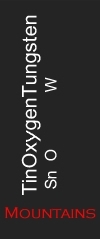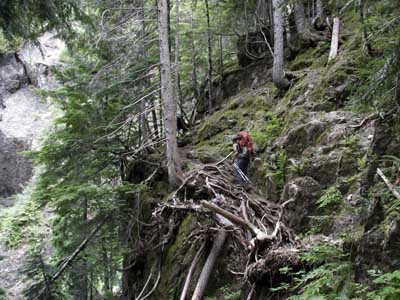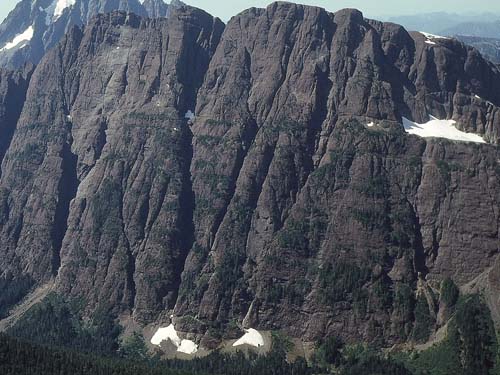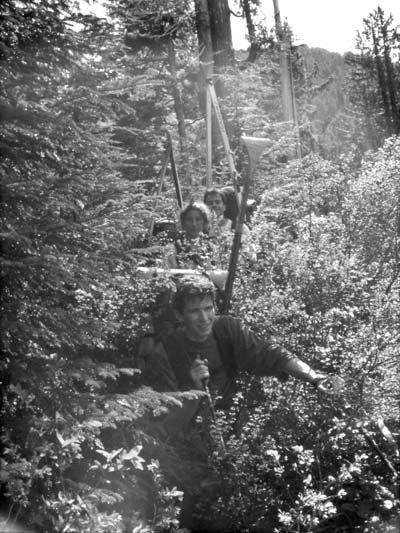 |
|
Bushwhacking as Ethos: Vancouver Island Mountaineering
This article first appeared in Canadian Alpine Journal 2006 as part of a series of articles reflecting on the state of mountaineering in Canada as the ACC turned 100 years old.
It’s a good thing that when the editor contacted me about writing a “… piece on how today's local [Vancouver Island climbing] ethos is rooted in the specific local past” he excluded the writing of a historical summary. My discussions over the past few weeks with numerous Island climbers have made it clear that this latter task would be a major project, and one for which I am eminently unqualified. Besides, Lindsay Elms already holds the place of Island climbing historian, and one can learn a great deal from his 1996 book Beyond Nootka and from his growing web resource of Island mountaineering history at http://members.shaw.ca/beyondnootka/. Lots of interesting Island mountain history has also been captured in scrapbook format by Bob Tustin of the Island Mountain Ramblers in his 1983 compilation called The History of Mountaineering on Vancouver Island.

In the paragraphs that follow I have deliberately avoided (well, almost) mentioning any names except in connection with published books. This is because there are too many names, and because this project is not about the cataloguing of achievements.
Strathcona Park contains many of the highest and most interesting peaks on the Island, and there is much in Wallace Baikie’s 1986 book Strathcona: a history of British Columbia’s first Provincial Park that contributes to an understanding of context for the Island mountain scene, including accounts of some of the early surveyors’ expeditions as well as a look at the first decade or so of Strathcona Park Lodge, the outdoor education centre that has its own special place in the Island mountain ethos. It is perhaps a little ironic that within a year or so of the publication of Baikie’s book the Park’s history gained a new and powerful chapter with the founding of the Friends of Strathcona Park and the beginnings of major civil disobedience to save the Park from being further gutted by mining, this time at Cream Lake. In the winter of 1988 more than sixty brave people were arrested in this action, their heartfelt attempt to preserve the wilderness values of their cherished park. They were successful, and the moving story of those events has been well told by Island climber Rob Wood in his 1991 autobiography Towards the Unknown Mountains.
In fact, the more I think about it, the more I am struck by the idea that to go mountaineering (I use the term in a broad and inclusive sense.) on Vancouver Island is to participate in a political act. We Island mountaineers occasionally comment, over a pint of ale, about our love-hate relationship with the logging industry. On the one hand we often relish and profit from the many roads that provide us access to our chosen objectives. On the other hand we see from the ground and from above the grand scale of devastation inflicted by society’s rapacious hunger for wood products and capitalism’s propensity to talk about sustainability but to pursue its opposite, viz., short-term profit. It seems to me that no long-term Island mountaineer can remain isolated from the political history of Strathcona Park, which includes having parts of the Park removed for logging and then returned, having a major mine established at its very core, and having its major lake flooded by the damming of the Campbell River, with the attendant loss of an area of old growth trees that has been referred to as equivalent to several Carmanah valleys. The catalogue of insults to our Park and our Island mountain wilderness is very long. We, as mountaineers who know the Island backcountry perhaps better than most others, must become even more political, for our role as mountaineers makes us participants in the political process. We cannot proceed complacently as if we were merely the beneficiaries of wise and dedicated forbears. My friends and I laughed when, in the late 1980s, the provincial government of the day labelled clearcuts as ‘multiple use recreation areas’, but that joke has long since faded, and it may be, alas, that the Clayoquot protests of 1993 are not to be the last of the kind of civil disobedience that seems to be required to protect our wilderness from corporate greed.
I have already used the word ‘wilderness’ several times. It has a direct connection to the input I received from a dozen or so Island climbers consulted for this article, input which can be distilled down to four words: exploration, bush, spirituality, and ferries.
The fact that we are an island has kept us isolated from the mainstream of the mountaineering community. A well-known group of young Islanders in the 1970s were able to broaden their experience through a connection to the Squamish Hardcore and to Yosemite climbing such that they became world-calibre climbers. Perhaps it is significant for us to admit that in order to accomplish this they had to leave the Island. [ One thinks of Darryl Hatton, Peter Croft, Greg Foweraker, Jim Sandford, Hamish Fraser, ...] Viewed the other way around, the prospect of a time-consuming ferry ride seems to have prevented most mainland mountaineers from checking out our ‘little Alps’. Some locals have contended that we have kept our mountains secret, and some that we ought to continue to do so. But by the time Dick Culbert, a mainland climber, had written his popular 1974 guidebook he had already pioneered the first route on the east face of Mt Colonel Foster. It was also in 1974 when local Joe Bajan made the solo second ascent of that impressive face, a face that has been compared favourably to the great faces of the European Alps. But there may be more than a wide moat keeping outside climbers from coming to the Island. It may be that our mountains are to mountaineers what Talisker is to scotch drinkers, something of an acquired taste. Or it may be that the climbing is not very good.

A interesting juxtaposition of ideas has emerged from my recent exchanges with Island climbers, a contrast that seems to be borne out when one checks the relevant literature, some of which I have mentioned. There is the idea that, with a few possible exceptions (such as the east face of Mt Colonel Foster, the south face of Mt Tom Taylor, and Wapiti Mainline (aka the Nomash Slab)) the Island has no great climbs. (Cartoonists exaggerate to make a point, and this argument should be viewed in that light.) A typical Island route is characterized, it is claimed, by poor rock and poor protection, so that one would never begin a big route unless one were pretty certain it fell within one’s climbing abilities. On the other hand, there seems to be considerable agreement that the Island mountains constitute a truly “restorative wilderness”, to use Chris Barner’s term. Rob Wood, in his foreword to Philip Stone’s Island Alpine guidebook, has written that the Island alpine is “… more than just pretty: it has a powerful welcoming ambiance. Nowhere that I have ever been has given me such a profound sense of being at home.” One friend claimed that the defining feature of Island climbing is the requirement to “become one with the bush”. Another very active Island mountaineer has offered that there is something almost spiritual about bushwhacking that helps keep him going back time after time into the Island ranges. This is perhaps to express in very general terms what Doug Scott, in his foreword to Rob Wood’s book, described as “… real forest – alive, natural, pristine with a vast variety of plant and animal life that smells good and is good for the soul…”
In summary, the Vancouver Island mountains contain little that rates on a world scale in mountaineering terms, but they contain a great deal that rates high in terms of personal enrichment, even for mountaineers whose ambitions include the climbing of great climbs. Moreover, the reason our Island mountains are so restorative and enriching is that they are, in contrast to many of the world’s other mountain areas, still relatively wild from valley to summit (and this somehow in spite of the myriad logging roads that are everywhere except in the parks). It is because of the relative paucity of trails, the lack of infrastructure, the near-absence of huts, and because of the great bushwhacking, that the Island mountains hold such power for receptive individuals. (The reader interested in an eloquent account of an enriching trek in the temperate rainforest would do well to look at ‘Megin: Tidewater to Treeline’ in Randy Stoltmann’s book Written by the Wind. Also, I find it sad that the little 1974 booklet Hiking in Strathcona Park, edited by Karl Stevenson, is not more widely available, for it is a sincere, spirited, and charming collection of stories presented by a staunch defender of the Park.) It is because of the wilderness and the bushwhacking that even the modern mountaineer on Vancouver Island can experience something of the exhilaration of exploration, and the accompanying requirement for self-reliance and personal responsibility, that engaged the surveyors, prospectors, loggers, botanists and mountaineers who have gone before. And it is only if we leave the few remaining wilderness parks undisturbed, and are very careful about how we use them, that this soul-restoring quality will remain available to future generations.
The above paragraphs sketch an outline of what might be called a Vancouver Island mountaineering ethos. A truly thorough account of the subject would colour in the outline with names and dates and climbs. The colouring-in would include comment on such varied topics as Jim Boulding and Strathcona Park Lodge, the friendliness and camaraderie of the Island climbing community, the development of Crest Creek Crags, the little-known part played by the UVic Rock Scaling Club in the 1970s, the interwoven roles of the various mountaineering and outdoors clubs, the crystallization point that is Fleming Beach crag in Esquimalt, the mysterious exploits of the Island’s climbing loners, and much more. But that would be a book. What remains for me to do here is to attempt a description of where climbing is now on the Island, and what the local past has got to do with that.
A couple of my correspondents lamented that in the last decade or more there has been a tendency for younger climbers to concentrate only on indoor climbing and on sport-climbing crags while ignoring the mountains. It is claimed that the recent generation of Island climbers isn’t motivated by the tradition of friendly (?) mountaineering competition and the desire to get to the ‘plum’ routes first. But there is also the observation that this has begun to change, and that more young climbers are now turning their talents to the Island mountains. And maybe, contrary to the tradition in world mountaineering, they are keeping quiet about what they do. That would be too bad, because I and others are interested. Records are useful even if only to prevent the embarrassment of claiming to have done first that which someone else has already done. It is good to be reminded that Adolf and Ulf Bitterlich (part of the first Canadian team to climb Mt Waddington) climbed at Horne Lake in the 1950s. It is good to be reminded that, as one old-timer told me years ago, someone already has returned from Marble Meadows by swimming across Buttle lake while towing his floating pack in a garbage bag.
Vancouver Island certainly has many more developed climbing crags now than when I first arrived here in the late 1970s, and more climbers. The age spread of climbers is greater and there are many more female climbers than in those days. And new climbing routes are being established, not just at crags but also in the mountains, as recent flurries of activity in the Mackenzie Range and the Haihte Range attest. But one still has the impression that these new Island mountain routes are being undertaken by only a very small handful of climbers.
It has taken a long time for climbing in North America to become anything close to as socially acceptable here as it has been for generations in Europe and Britain. But perhaps with acceptability has come mundanity? Maybe it is because climbing has become so acceptable that there seems to be less motivation to seek challenging mountain routes. It has simply become a less renegade thing to do. Maybe competition has become unfashionable. Or maybe competition is fashionable now only if it is on reality television. These observations are not unique to the Island, but they are part of our modern context.
But Barry Blanchard has been by recently to remind us that mountaineering is a sport that can take all you have to give. It is an unfillable sink for all your youthful energy. All you have to do is keep the playing field reasonably level and you will be engaged to the full. Vancouver Island is three quarters the size of Switzerland and its highest mountain has had perhaps only one winter ascent! Mount Everest sees more winter traffic than that. Long-time climbers up and down the Island have their ‘secret’ lists of objectives, their great projects that await the right weather, conditions, partner, or period of unemployment. What is perhaps surprising is that everybody’s list is still so long. Perhaps this will change.
History is beginning to repeat itself. A generation after what may fairly be called the first wave of high-end Island climbers to become established in the outside climbing world, the last half-dozen years have seen the emergence of a small but very talented cadre of Island climbers who have again experienced the necessity of leaving Vancouver Island in search of greater challenge and variety. These they have found, to impressive effect, in such places as Baffin Island, Greenland, Southeast Asia, and BC’s own Coast Mountains. Maybe they will come home from time to time and lead the way to some new and ambitious Island mountain routes. (One thinks of Matt Maddaloni, Katy Holm, Jacqui Hudson, John Furneaux, and Nick Elson, to name a few)
Here on the Island it is still possible to go to the mountains and feel not only alone but also as if one is in a place where few people have been before. The sense of wilderness and exploration remains strong, and I think a renewed sense of adventure is building. I believe we are at the beginning of a vigorous resurgence of Island mountaineering, and I am very much looking forward to it. May we exercise the wisdom to tread gently on the wild places we love, and may we not be too greedy about trails, lest our children’s children be robbed of the experience of becoming “one with the bush”.
Sandy Briggs
